Flush With Fuchsias
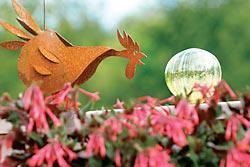
SHARON BERRY'S Bellevue garden kept on blooming through the long, hot summer of '06. Hardy fuchsias are her secret. The intricate pendant flowers of these little shrubs are draped in borders, beds and pots all over the place. Undeterred by the hard freeze last winter, her fuchsias burst into bloom in June and survived the heat of July and August. If autumn stays mild, they'll flower into December.
The humble hardy fuchsia is looking like the plant of the year, perhaps the plant of the future.
"They might droop at 3 p.m., but the next morning they'll bounce back and you'd never know it had been a 90-degree day," says Berry as proudly as if she were talking about especially clever grandchildren.
It isn't just for their plucky perseverance that Berry has collected more than a hundred different types of hardy fuchsias. She enumerates their virtues:
Hummingbirds adore fuchsias while slugs leave them alone. Fuchsias range from barely a foot to 4 feet tall, so they fit neatly into the front, middle or back of the border. Fuchsias don't grow beyond their allotted space, they never need dividing and they don't self-seed. Fuchsia foliage has presence even before the bloom kicks in — the leaves varying from large and soft to tiny and hazy. And unlike most flowering plants, fuchsias bloom continuously for six months; their bloom really gets going when the weather cools in September and October.
But how about hardiness? Gardeners used to big, blowsy fuchsias, those chorus girls of hanging baskets, will find it hard to believe that fuchsias planted in the ground will persist year after year. Berry advises that hardiness depends on your soil and drainage, because more fuchsias are lost to soggy soil than to winter cold. Berry figures that more than 90 percent of her fuchsias are reliably hardy. "If they all came back I don't know what I'd do," says Berry, gesturing at the hundreds of fuchsias happily thriving away in their pink, peach, salmon, orange and purple glory.
No garden gets by on a single genus alone, so how does a fuchsia fancier integrate her favorite plants with others? Berry avoids the big, overblown doubles, preferring the more naturalistic-looking single-blossomed fuchsias that are better mixers. The lacy look of nandina, astilbes, maidenhair ferns and Japanese maples combines well with the delicacy of the fuchsias. Berry mixes in large-leafed perennials like hostas, brunnera, rodgersia and hellebores to contrast with the airiness of the fuchsias. For winter structure, she grows evergreen shrubs such as rhododendrons, and trims out the beds with impatiens, hardy geraniums and plenty of ferns.
Berry delights in putting fuchsia myths to rest. No, they don't necessarily need shade; some fuchsias do just fine in full sun, such as the hot pink and purple 'Voltaire.' Berry advises that the popular 'Gartenmeister Bonstedt' fuchsia, which we all regretfully think of as an annual, will sometimes overwinter. Berry admits to some grooming, but doesn't pinch and pamper. "The more you pinch, the later the flowers come on, and I love the flowers," she says. Any hardy fuchsia can be grown in a container; the lax ones are particularly effective because they cascade gracefully down the sides of the pots. "I used to have marigolds and geraniums," Berry says, "now I just grow fuchsias!"
Valerie Easton is a Seattle freelance write. Her e-mail address is valeaston@comcast.net. Mike Siegel is a Seattle Times staff photographer.
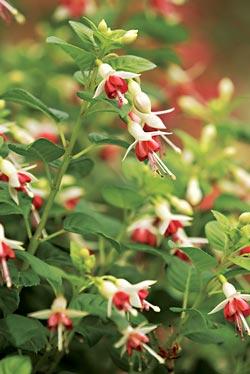
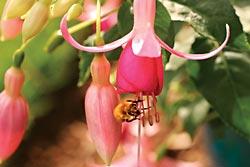

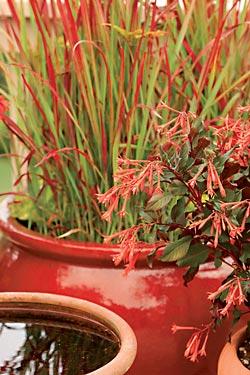
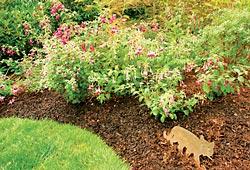
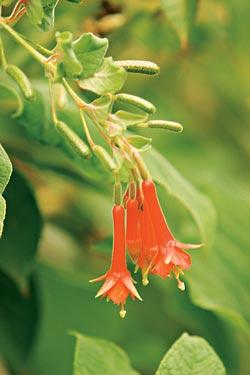
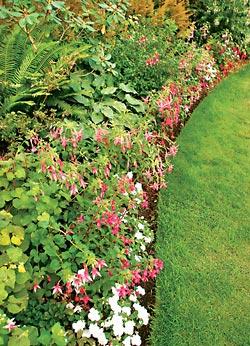
Proper care and feeding
![]()
![]()
Fuchsias need lots of fertilizer to thrive. Sharon Berry mixes a liquid fertilizer such as Miracle-Gro or Peters 20-20-20 half strength and doses her fuchsias every 10 days through early September. Then she quits fertilizing to let them harden off for winter. Other tips:
• Fuchsias need good drainage, compost and watering during drought. Berry mists her fuchsias and waters them by hand on the hottest days of summer.
• Mulch fuchsias well for winter, then leave them alone. You can trim off the lanky tops but leave the stems intact to protect the roots from freezing. In spring, pull back the mulch gently to find the sprouts growing, then cut back the dead stems.
• Find knowledgeable fuchsia fanciers, reliable information and a list of sales and events at www.nwfuchsiasociety.com.